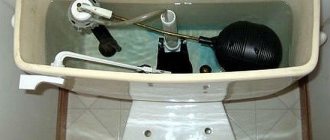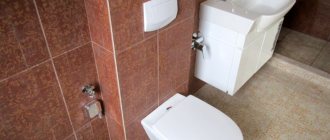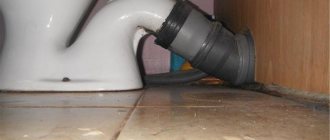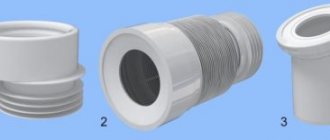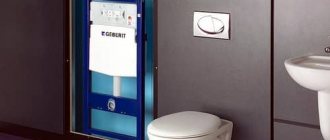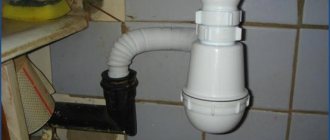I don’t want to imagine comfortable living conditions without such a plumbing fixture as a toilet. In order for it to function normally, the property owner must know its design features.
No matter what the toilet looks like, the filling in the cistern will be similar
How the toilet cistern works: the internal filling of the device
The normal operation of the drainage system is ensured through the interaction of its individual components. The water supply to the container is carried out thanks to the fill or inlet valve for the toilet. It is represented by a threaded pipe that is inserted into a hole in the side wall or bottom of the tank. The presence of a thread allows you to press the element to the tank wall using nuts, which will ensure a tight connection. Control over the opening and closing of the hole through which water enters is carried out by a locking mechanism connected to the rocker arm.
The principle of operation of the flush mechanism in the toilet cistern
The rocker arm is the lever that moves the exhaust valve. The free end of the element is attached to a float or control valve. A float is a plastic sealed container with air inside. At the moment when the float floats up or the shut-off device is activated, the rocker arm rises, which helps to close the gap in the filling valve or vice versa.
In normal condition, the drain hole is closed by the drain valve. This is a flat or hemispherical elastic gasket that connects the load-bearing part to the hinge mount.
The operation of the drain mechanism for the tank is controlled by a push-button or lever mechanism, which is located in the upper part of the tank. When exposed to it, its load-bearing part rises, opening a hole for water to flow at high speed into the toilet bowl.
All components of the mechanism can be arranged in different ways. In older models of tanks, the flushing and water overflow control mechanisms were mounted separately. In modern models, shut-off valves are presented as a single complex, which facilitates easy installation and configuration, while at the same time complicating repairs.
Water is supplied to the tank capacity through a fill or inlet valve
Toilet device
The toilet includes the following elements:
- A toilet bowl connected to a sewer pipe with a sealed cuff.
- Drainage tank with fittings that allow it to be filled with water and drained.
A water supply hose is connected to the tank. Depending on the design, it is connected from the side or from the bottom. The bowl and cistern are usually connected to each other using bolts and a seal.
Accessories components:
- rod release mechanism with drain button;
- a shut-off device (inlet valve) connected to a float;
- rubber sealing gaskets.
How a toilet flush mechanism should work
The flush mechanism for the toilet is located inside the tank. It does not have a complex design, but it performs important functions. The drain mechanism is responsible for draining water from the tank, filling the container with water, and controlling the water level, which eliminates the possibility of the tank overflowing when the liquid reaches a certain level.
The principle of operation of the drain tank is as follows. Water enters the container through a fill valve, which may be located in the wall or bottom of the tank. As the container fills, a shut-off device in the form of a float or valve is activated, which shuts off the supply of liquid when it reaches a certain level, blocking the filling valve.
When it becomes necessary to flush the water, the button or lever is pressed, which opens the shut-off valve of the toilet cistern. As a result, liquid enters the toilet bowl. Double button systems work similarly. When the small button is pressed, part of the water is poured out of the tank, when the large button is pressed, a complete drain is performed.
Important! The flush mechanism of the toilet tank with a button for two modes ensures water saving.
Water can enter the tank through a valve located in the bottom or wall
Draining the water entails a decrease in the liquid level in the container. This helps activate the control devices, as a result of which the outlet valve opens and the tank fills with water.
Preparation for repair
Before you can repair the toilet cistern, you need to open it. It is only accessible from the top if you remove the cover. In many modifications it is attached using a ring around the button. This ring must be pressed and turned counterclockwise. After prolonged use, the ring may not turn. Then a few drops of oil are applied to the attachment point. After the ring has turned, unscrew it, and then release the button from the plastic clothespins and remove the cover.
USEFUL INFORMATION: Replacing a sewer pipe in an apartment: at whose expense, price
Models are equipped with one or two buttons. In the second case, one of them is intended for a small flush, and the other for a large one. To dismantle the cover, press one button and remove both of them one by one through the technological groove. Then unscrew the fastening screw and remove the cover.
Types of drain fitting design for toilet cistern
There are several options for the drainage system. The filling valve can be bottom or side mounted. In the first case, the pipe is located in the bottom of the drain container. This system includes a vertical rod float, a rod and a buoy. The last two elements are connected into a common structure, which acts as a water limiter.
When the tank is empty, the float lowers. At this moment, draft begins to act on the toilet valve, opening it. When the float reaches a certain level, the valve closes. Sealing of the system is ensured by a pair of gaskets.
When placed on the side, the pipe with the valve is inserted into the tank through a side hole, which is located in the wall of the container under the lid. This gap is made conditionally sealed, since water does not reach it. In this design, the control mechanism of the flush tank is placed horizontally. It consists of a shut-off device, a float, a lever and a filling tube. When the tank is emptied, the float lowers, which moves a rod that opens the shut-off valve. When the tank is filled with water, the control mechanism gradually rises.
In a side-valve design, the mechanism is located horizontally
From the point of view of efficient and comfortable operation of the drainage device, it is better to choose models with a bottom connection, which are more reliable and make less noise when the container is filled with water. Systems with side connections are characterized by ease of installation and ease of adjustment and repair work.
Important! Tanks with bottom connections require close attention to the tightness of the connection.
The flush mechanism is activated by a trigger, which can be a lever, a rod or a toilet button. Older models were equipped with a lever to which a cord with a handle or a chain was attached. The drain system with a rod was activated by lifting the handle up. This option has also lost popularity and is rarely found in modern tanks.
Bottom-mounted designs are more reliable
Currently, models are most often controlled by pressing a button located in the tank lid. The push system, in turn, can be one-button or two-button. In the first case, the tank is completely emptied when you press the button. The second option involves two modes of operation of the tank drain mechanism with a button. The first ensures that half the volume of the container is drained, and the second ensures that the tank is completely emptied.
Types of toilets according to bowl geometry
The shape of the bowl should be such as to provide maximum comfort during use, a high level of hygiene and functionality. There are several forms of the product:
- Funnel-shaped bowl. The main advantage of this geometry is hygiene. This is achieved by the special position of the funnel - it is located in the very center of the bowl. The funnel allows you to very quickly and thoroughly remove waste products. The disadvantages include a splash, which with such a structure will definitely occur - design features.
- Plate-shaped bowl. This design features a flat platform where waste accumulates. The platform can be cleaned only with water jets. This is an outdated solution, although the shape prevents splashing. Devices with similar geometry are less common on sale, since its hygiene is extremely low.
- Visor bowl. Widely used bowl geometry. There is a ledge that prevents splashes. A special shape with a slope allows you to wash off feces from the walls without leaving a trace.
Types of toilet flush valve as a system overflow control mechanism
The toilet cistern flush valve can be a float or membrane shut-off device. Models of the first option may differ in structure and principle of operation. Old tanks were equipped with Croydon valves, which consisted of a body, piston, axle, seat and float lever. When the float lever was acted upon, the mechanism began to function. In this case, the piston moved vertically.
Most modern drain mechanisms are equipped with a piston valve, which moves horizontally when the lever is pressed. The water supply is regulated by the contact of the piston and the seat. When the container is filled, the inlet hole is closed using a gasket located at the end of the piston.
The diaphragm valve is not equipped with a piston gasket, but with a rubber or silicone membrane. When a lever acts on it, the plastic piston begins to displace the membrane, which closes the water supply.
The drain valve can be equipped with a membrane or float mechanism
Important! The diaphragm valve facilitates quick and silent filling of the tank.
The disadvantage of this element is the greater sensitivity of the product to dirt and the presence of impurities in water. The diaphragm valve will quickly lose its operational properties due to poor quality water in the system. A mechanical cleaning filter will help avoid problems.
There are floatless options for the drain system. The water supply to them is stopped due to the presence of a special chamber shaped like an inverted glass.
Material for making toilet flush valves
Expensive models of toilet flush systems are made of bronze or brass. These materials are characterized by strength, reliability, corrosion resistance, and the ability to withstand mechanical and chemical loads. The design can be either simple or complex. Metal filling is found in expensive collectible models, which are produced with a certain stylization.
Most drain valves are made from polymers
In other cases, bronze and brass can be used in the manufacture of only the fill valve, which makes the shut-off and drain system universal, easy to install, configure, repair, and allows you to replace each unit individually.
Many valve models are made from polymers. The quality of plastic and precision of production affect the cost of the product. The more expensive the fittings, the more reliable and durable the drainage system will be. However, there are high-quality models that have an affordable price.
Tank Troubleshooting
The tank may leak water due to a crack in it. The same applies to the cup. In this case, the question of how to repair the flush tank or bowl does not arise: the entire toilet is usually replaced. A small crack in the top of the ceramic pieces can be repaired. To prevent it from spreading further and increasing water seepage, it is drilled at the ends and treated along the entire length with sandpaper. The work is done carefully.
If the crack progresses during operation, the toilet should be replaced.
The surface is degreased and the gap is filled with epoxy resin. After hardening, the seam is sanded.
USEFUL INFORMATION: Installation for the toilet, what is it, how to choose?
How to choose the right toilet parts
If elements of the drain system fail, it is important to choose the correct option that will correspond to the factory configuration. The units may differ in the material they are made of. Products made of bronze and brass are considered the highest quality and most durable. However, they are characterized by high cost.
The repair kit for the toilet is selected based on the model of the tank. Important parameters are the location of the inlet, its size, the diameter of the drain opening and the overall dimensions of the device, which must fit freely into the tank. The flush mechanism for a toilet can be represented by a single design or consist of separate (drain and fill) devices. The second option significantly facilitates and simplifies the process of replacing products.
If elements of the drain mechanism break down, the repair kit is selected based on the model of the tank
When choosing a valve, you should pay attention to the quality of the product. The mechanism must operate under its own weight. It is necessary that all its components are movable, move smoothly and unhindered. There should be no jamming of any kind.
When choosing a drain mechanism, you should carefully inspect the elements. They must have a solid body, free from chips and cracks, and the correct geometric shape, which will contribute to efficient and uninterrupted operation. Spare parts for toilets made from high-quality material have a high cost.
Seals and gaskets should be purchased from silicone. Such products, unlike rubber ones, are characterized by strength, reliability and durability. Elements are checked for compression and bending. They should not be deformed or cracked.
Helpful advice! The best performance and strength properties are provided by sealing elements, in the manufacture of which rubber is added to enhance elasticity.
New mechanism parts must be of high quality, without chips or cracks.
Wall hung toilets
Scheme of the structure and connection of the toilet.
Suspended devices have become widespread in Europe. In the last 10 years, such suspended structures have become very popular in our country.
The advantage of such a device is:
- easy care;
- high hygiene.
Due to the fact that the toilet bowl does not have a support, it has become very easy to clean the floor of such a toilet. The flush tank is hidden in the wall and is almost invisible. However, this design requires the installation of a supporting frame, which must have a rigid metal frame.
The frame is secured to the floor with anchor bolts. For higher reliability, if possible, it is additionally attached to the wall. This design can withstand 400 kg.
A toilet bowl is installed on the frame, together with a flush cistern. The entire structure is covered with plasterboard sheets. Only the toilet and the flush button remain visible.
Main parts of the toilet:
- Cistern.
- Bowl.
- Seat.
The main part of the bowl is the hydraulic valve. This is a crooked channel that is always filled with water. Its operation allows wastewater to go into the sewer. Such a siphon does not allow bad odors to pass through and blocks blockages.
Dismantling and installation of the flush mechanism for the toilet cistern
If the drain mechanism fails, you can replace it with a new repair kit yourself. Replacing the flush mechanism in the toilet cistern is carried out according to the following algorithm.
Related article:
How to choose a toilet: main criteria and features of various models
Review of the 5 most popular manufacturers and models. Common breakdowns and ways to fix them.
The first step is to turn off the water supply. Next, press the drain button to empty the tank. It is carefully removed, which makes it possible to remove the tank lid. Then the water supply hose is disconnected. The nut that secures the filler pipe is unscrewed. You need to remove the part itself from the hole.
Helpful advice! Before changing the flush mechanism in a toilet cistern with bottom water supply, it is recommended to install a small container under the plumbing fixture into which the water that does not go down the drain will drain.
The internal fittings are removed from the tank and unscrewed from the fasteners. Next, unscrew the bolts securing the tank to the toilet bowl. The container is removed. After this, the lower part of the drain system is dismantled and the sealing gaskets are removed. After disassembly is completed, it is necessary to clean the inner surface of the tank and all its openings, remove plaque, debris and lime deposits.
After removing the internal fittings, it is necessary to unscrew the bolts securing the tank and toilet
Installation of the drain mechanism involves the reverse sequence of work. The lower part of the drain system is inserted into the hole, and sealing gaskets are attached. Next, install the flush cistern on the toilet and secure it with fastening bolts.
Important! If corrosion has formed on the old bolts, the elements should be replaced with new ones.
The internal part of the flush mechanism is installed in the toilet siphon. The fill valve should be inserted into the gap in the bottom or side wall of the tank, securing it with a nut and sealing gaskets. A water supply hose must be connected to the outlet pipe. The water is turned on and the system is checked for functionality.
If all elements are installed correctly and the joints are securely sealed, then there will be no leaks.
The filling valve is inserted into the side wall of the tank or into the bottom
Installation and replacement of cistern fittings
A significant part of toilet problems can be solved by adjusting or replacing the tank fittings. In any case, you need to know how to disassemble and assemble the insides of the tank. This skill will definitely come in handy. When replacing, you first need to dismantle the old device and then install the new one. We will describe in detail the entire process, including the installation of new fittings.
How to remove the cap from the tank
If a flush tank with a button is being repaired, it is not always immediately clear how to remove the lid. This is easy to do: press the button and turn the ring.
How to remove the lid from a tank with a button
If you can’t press the button with your fingers, examine its inner rim. There are two special slots there. You can take a screwdriver with a narrow end and use it to turn the ring a little. Then you can unscrew it with your fingers.
After this, remove the button by pulling it up. That's it, the lid can be lifted.
Removing the tank
To replace the old cistern fittings, it must be removed from the toilet bowl. First of all, turn off the water supply, then drain the water from the tank. Then, using wrenches, remove the water supply hose (it is attached to the side or bottom).
When the water supply is located at the bottom, it is located next to the mounting studs
Next, you need to disconnect the tank from the toilet bowl. If you look underneath it, you can see bolts that are tightened with nuts. So we unscrew them using a set of open-end wrenches or an adjustable wrench. Before doing this, place a container or a rag near the toilet - a certain amount of water always remains in the tank, and when you unscrew the nuts, it will drain.
After unscrewing two nuts - on the right and on the left, we remove the tank. There is usually a gasket left on the bowl. If it has become deformed or dried out, it is also advisable to replace it.
Remove the drainage tank from the bowl
Place the tank on a flat surface. There is a large plastic nut at the bottom. It holds the drain mechanism, we unscrew it. Sometimes the first turns have to be made using an adjustable wrench, but do not over-tighten it - the plastic can be brittle.
Unscrew the nut holding the drain mechanism
Now the water drainage mechanism can be easily removed.
This is what the cistern fittings look like after several years of operation.
Similarly, remove the water supply mechanism. With bottom feed, the fastening nut is also located at the bottom (right or left of center).
Water supply mechanism fastening nut
This was the removal of the water supply device to the tank
After that, we look inside the drain tank. Usually, rusty sediment, small metal particles, sand, etc. accumulate at the bottom. All this must be removed and, if possible, washed. The inside must be clean - any debris caught under the gaskets can cause a leak. After this, we begin the installation of new fittings.
Installation of cistern fittings
Everything happens in reverse order. First, we install a new drain mechanism stand. We unscrew the plastic nut from it and put a rubber gasket on the pipe. It can be white (as in the photo) or black.
We put a rubber gasket on the thread
Place the device inside the container and screw the plastic nut on the outside. We twist it as far as possible with our fingers, then tighten it a little with a wrench. You can't overtighten it - it will burst.
Install and tighten the nut
Sealing
Now on the toilet bowl we replace the o-ring that seals its connection with the flush cistern. Dirt and rust often accumulate in this place - we wipe it off first, the seat should be dry and clean.
Install the O-ring
We install mounting bolts inside the tank, not forgetting to put gaskets. We put the drain tank in place until it can be leveled. The main thing is to get the screws and the outlet part into the seats. Take a washer and nut and screw them onto the screws.
Tighten the fastening
When both nuts are installed, but not yet tightened, level the container. Then, using a wrench, we begin to tighten the fastening. We turn it a few turns, first from the right, then from the left.
Install the exhaust valve
Lastly, install the inlet valve for the drain tank. It could have been installed earlier, but then it would be inconvenient to install the mounting bolts - there is too little space. We also put a gasket on the outlet pipe, then install it inside and secure it with a nut.
Tighten the intake valve mounting nut
The next step is to connect water to the same pipe. Before connecting the flexible water hose, open the water for a while, giving the opportunity to remove scale, which accumulates every time after closing the tap, even for a short time. After draining a certain amount of water (place a bucket so as not to wet the floor), connect the hose to the fitting (turn off the water again).
Connecting water to the toilet tank
Although the fitting is metal, there is no need to tighten this connection too much - first with your fingers, then one turn with a wrench. If you notice drops when you turn on the water, you can tighten it another half turn. After this, we check whether the system is working correctly. If everything is correct, install the cover and screw the button. You can test it again. This completes the installation of the drain tank fittings. As you can see, everything can be done with your own hands.
Testing the toilet flush system after installation
After installing or repairing the toilet cistern flush mechanism with a button, the system is tested. The first step is to check that there are no visible leaks. To do this, you need to run water through the plumbing fixture several times. Water should not flow into the toilet bowl unnecessarily, and you should also make sure that there are no leaks underneath. If they are detected, it is necessary to fix the fastenings as firmly as possible.
Next, it is checked whether the water level in the tank has reached the required level. If this does not happen, the toilet tank is adjusted. The filling valve should work normally and not stick. You can verify the quality of its operation by applying sharp downward or upward pressure to the mechanism.
Next, you need to evaluate the operation of the system by ear. If there is a hissing, whistling, or other sharp sound, this indicates that the flapper valve is closing. The problem is resolved by lowering or raising the element using a screw, which is driven by a screwdriver.
To ensure normal operation of the system, the water level in the tank is adjusted. The float, which is held in place by a thick wire, should be placed so that it is located 1-2 cm below the edge of the reinforcement. To gain more water, the metal lever needs to be bent in an arc downwards. To reduce the liquid level, the product is bent in the opposite direction.
After installing the drainage system, it must be tested
If the float lever is made of plastic, its adjustment is carried out by a special screw, which rotates until the float takes the desired position. The optimal level of liquid in the tank is considered to be at which the water will be 3 cm lower than the overflow hole.
The correct position of the buoy indicates that water does not overflow through the system and does not go into the toilet bowl unnecessarily. After adjustment, the lid is installed on the tank and secured with a button.
Adjustment and repair
When using the toilet, problems periodically arise - sometimes it flows, sometimes, on the contrary, water does not fill into it. Sometimes, tired of the inconvenience, people buy new toilets. But in vain. Most faults are resolved in 10-20 minutes. Moreover, everything is so simple that anyone can do it. You don't have to call a plumber. You can do everything yourself.
Adjusting the water level
We will talk about devices with bottom water supply. After installation, the toilet cistern must be adjusted. By default, they come from the factory set to the maximum amount of water in the container. This amount is often excessive. With the help of simple adjustments we can reduce the volume of water in the tank. For this:
- Turn off the water supply and drain the water.
- Unscrew the button.
- Remove the cover.
Where is the adjustment screw located?
- There is a plastic screw on the float mechanism. By unscrewing/twisting it we change the amount of water. If you need to reduce the amount of water, tighten the screw, lowering the float down. The next time you fill (you can turn on the water), the water level should drop.
- Reinstall the cover and button.
The same procedure is necessary if water is constantly leaking from the tank. One of the reasons is that the float is raised too high. Because of this, water flows through the overflow system.
With a side water supply and a float mechanism, adjustment is even simpler - we change the position of the float by bending its lever. On the one hand it is simpler, but on the other hand it is more difficult. You have to bend it many times to achieve the required level.
By bending the float lever we change the water level in the drain tank
Toilet tank is leaking
If the water in the toilet constantly leaks and its level is normal, we move on. There are several reasons for this leak. And if so, then the methods of elimination will be different.
- The rubber seal under the drain valve in the tank has silted up, dirt has gotten under it, and a groove (or several) has appeared on its surface. The method of treatment is to clean the existing gasket or replace it with a new one. To resuscitate the old one, you need to: turn off the water, drain it,
- remove the drain mechanism by unscrewing the plastic nut from below;
- pull out the drain valve, remove and examine the gasket, clean it of settled particles, if necessary (there are grooves), sand it with very fine sandpaper until smooth;
- install it in place, connect everything and check operation.
- The trigger mechanism itself was demolished. To check whether this is the case, you can lightly press the mechanism with the cover removed. If the leak stops, that means this is the problem. If it still leaks, you should try cleaning the gasket (described above) or replacing it. If the flow stops when pressed, you can replace the fittings or make the glass heavier.
Where to put the weighting agent
To do this, remove the release mechanism and place something heavy in its lower part. This could be several pieces of metal, a sock filled with pennies, sand, etc. We install the device in place and check the operation.
Possible system malfunctions and ways to eliminate them
Studying the principle of operation of the toilet will help identify possible malfunctions and eliminate them. If the overflow control does not work, you need to find the reasons that caused the damage to the system. The most common may lie in the misalignment of the lever or rocker arm that holds the float. It must be aligned, which will ensure the correct movement of the float and the restoration of the system.
For toilet flush systems with a membrane valve, when the element moves to the upper position, the hole may remain open. In this case, the position of the membrane is adjusted or replaced. The reason for the failure of the overflow control system may be perforation of the float with water ingress. This problem requires a complete replacement of the element. If the above operations do not resolve the malfunction, it is necessary to replace the inlet valve.
There are many reasons for a malfunctioning tank drain system.
A leak at the fill valve occurs primarily as a result of wear on the sealing gasket. In the early stages, the problem can be eliminated by tightening the fastening nut. In advanced cases, you will need to replace the gasket.
If the drain button does not work, the cause may be a misalignment of the lever that connects it to the drain valve. Such a malfunction may occur due to the breakdown of plastic elements of the internal fittings. In this case, replacement of the drain mechanism is required.
During the initial operation of the tank, problems may arise as a result of incorrect adjustment of the system. To ensure its functionality, it is necessary to select the height of the drain cup corresponding to the height of the tank, fixing it in the correct position.
If weak pressure is observed while filling the tank at normal pressure in the general system, the water supply hose is dismantled, cleaned, and lime deposits that have blocked the lumen are removed. If cleaning cannot be done, the hose is replaced with a new one.
A misaligned lever may cause the button to not operate.
If the problem is not resolved, you need to inspect the intake valve and check its functionality. To do this, open it, clean the inner chamber and adjust the overflow system. If the problem persists, the valve must be replaced.
Do-it-yourself methods for repairing the tank mechanism
Through the upper hole in the tank the entire mechanism of the drain fittings is visible. It may have the following faults:
- The tank is constantly leaking.
- There is no water pressure at the inlet.
- Uncontrolled drain mechanism.
The causes of these malfunctions can be different, and the method in which the toilet cistern will be repaired depends on them.
- The plug (bulb) does not fit tightly to the drain hole. To avoid this, you should purchase high quality plumbing fixtures. The possibility of repair can be checked by pressing the rod with slight force. If water does not flow, the plug can be slightly weighted with additional weight or the stem can be leveled. You also need to periodically clean the seal from rust and salts, due to which the seal is broken and liquid constantly flows into the bowl.
- The regulator does not shut off the water supply. At the same time, the tank will never overfill, thanks to the presence of an overflow tube. The serviceability of each element of the device is checked: float, intake valve, fasteners, rod. The failed part is replaced or the float mount is simply tightened.
- Leaking from the tank into the room. It may have a crack or the gasket seal may be broken. Particular attention should be paid to the quality of the connection between the current tank and the bowl. It needs to be tightened, and if this does not help, the rubber gasket is changed. Another cause of a leak may be wear of the cuff at the junction of the bowl drain with the sewer pipe. The seal is replaced with a new one, having cleaned the connection of contaminants and treated the surfaces with sealant.
- Weak pressure through the inlet valve. This usually happens if it becomes clogged. This can be prevented by cleaning or installing a filter in front of it.
USEFUL INFORMATION: Odors from the ventilation in the toilet: blowing in the opposite direction, letting in
Popular manufacturers of toilet cistern flush devices
One of the most famous manufacturers of plumbing products and spare parts for them is the Czech company Alka Plast. It produces high-quality, functional and durable products at an affordable price. A popular universal model is the AlkaPlast A2000 drain mechanism with a stop button function. The device is suitable for replacing the existing mechanism in ceramic tanks. Thanks to the special design, the height of the product can be adjusted within the range of 310-405 mm (depending on the height of the tank).
The device is equipped with a stop function button, which starts draining the water when pressed for the first time and stops it when pressed again. The mechanism is made of ABS plastic, which is resistant to abrasion and various types of loads. You can buy a drainage device for 850 rubles.
The Alka Plast A08A dual-flush drain mechanism has two modes of water release with a volume of 3 and 6 liters. The design of the device allows you to adjust the height of the drain mechanism within the range of 315-450 mm. The product is made of ABS plastic. The cost of the device is 1.1 thousand rubles.
The Czech company Alka Plast produces high-quality and durable drainage devices
Another equally popular manufacturer of toilet flush mechanisms is the Swiss company Geberit. The products of the global manufacturer are of high quality. The company is constantly improving its manufacturing methods for sanitary ware, introducing technological innovations.
Among the popular models of drainage systems, one can highlight the Geberit Impuls Basic 230 dual-flush mechanism, equipped with a chrome button. The device is made of durable high-pressure plastic, which increases its technical and operational properties. You can buy a flush mechanism for a Geberit toilet for 2.3 thousand rubles.
A high-quality model is the Geberit Impuls Type 290 drain mechanism, designed for two operating modes - drain for 3 and 6 liters. The device is intended for tanks with a height of 300-450 mm. The water supply can be carried out both from the side and from below. The cost of the Geberit drain mechanism is 2.8 thousand rubles.
The drain mechanism is a simple design. Having understood the principle of its operation and following the above tips, you can independently install, adjust and repair the device without completely replacing the toilet cistern.
Device diagram
This device appeared quite a long time ago; it was used several centuries ago, but then it did not become popular due to the lack of water supply and sewerage systems. The design of a modern toilet is much more complex than that of its predecessor.
The device consists of a bowl, a tank, shut-off valves and a drain assembly designed to release water (read: “Shut-off valves for the toilet - selection and rules for replacing the valves of the tank for draining water in the toilet”). The diagram shows how the toilet is structured in section - in the upper part of its bowl there is a seat with a lid. The device has a simple design, but there are certain nuances regarding the operation of the drain.
Methods for installing a toilet cistern
The toilet cistern can be attached in three different ways:
- The first method looks like this: the structure is installed directly under the water flow, and you need to combine it into a whole system with a toilet using tank fittings. The scheme may not look very nice, but it is capable of providing good water pressure at the time of its descent.
- The second installation method is that here the flush tank is mounted on the toilet itself. In most cases, this is done when you need to replace an old tank that was installed using the first method. The main advantage of this installation option is that the tank and lid are placed in plain sight, and maintenance and repairs can be carried out as simply as possible.
- The third method of installing a drain system tank is that the structure will be embedded in the wall. The main disadvantage of this installation scheme is the repair of the wall. The advantages of this method include: complete invisibility of the tank and space saving.
Operating principle of dual-mode drain
To save water, the tanks are equipped with a double liquid reset button. They provide a two-mode flush mechanism for the toilet: one regular one - for releasing water in full (4, 6 or 8 l); the other is a reduced mode, designed to drain 2, 3 or 4 liters of liquid. This system reduces water consumption.
But at the same time, it is whimsical from the standpoint of customization and repair. This is due to the fact that this mechanism has an increased number of mating interacting parts, which means an increased risk of breakdown.
Main causes of breakdowns
Malfunctions in the drainage systems of household toilets usually occur after 2-3 years of operation; they can manifest themselves in different ways. Quite often, the gasket or membrane begins to leak: as a result, water constantly flows into the bowl, and yellow stains of rust form on the walls of the toilet due to the salts present in the water. Problems with the fittings also manifest themselves as interruptions in the flow of water into the tank, and the system stops working automatically.
Here are some of the most common causes of device failures:
- Low-quality materials from which the fittings are made. If the device is made of fragile plastic, it quickly deforms and ceases to cope with its task. The solution to the problem is to replace the fittings with a better set.
- The water is too hard. It may contain an excess of calcium and magnesium salts, as well as active chlorine, which is used in water supplies for disinfection. Under the influence of aggressive substances, the plastic of the device quickly deteriorates and requires replacement.
- Float seal failure. If water starts to get into it, it will sink and stop coping with its task.
- Violation of installation rules. Unprofessional tampering with the device can also lead to breakdowns over time.
To replace the fittings and restore normal operation of the device, you do not always need to call a specialist. Many elements of the locking mechanism can be changed or repaired on your own; this does not require special knowledge.
Toilet cistern repair
Probably the most common problem associated with the operation of drain tanks is the appearance of leaks. Needless to say, this situation is undesirable, especially if the apartment has a water meter (a leak will lead to additional costs).
The main causes of leaks
Among the entire range of reasons that can cause a tank to leak, the most significant and common ones can be identified:
- Violation of the tightness of the bulb or gaskets (petals).
- Float adjustment is incorrect. In this case, the water will pass through the overflow level and flow out.
- When flushing water, there is a leak between the tank and the toilet platform itself.
- Violation of the tightness of the connection between the hose and the float valve.
- Loss of tightness in the threaded connection of the tank and toilet.
Troubleshooting Methods
To carry out repair work aimed at correcting any malfunction, the first step is to remove the top cover of the drain tank.
Violation of the tightness of the bulb or gaskets
Cistern bulb
In this case, there is a constant flow of water into the bowl. To eliminate the problem, you need to take out the pear and inspect it carefully.
With prolonged use, deformation of the bulb and gaskets or the formation of plaque on them is possible. You will need to wipe these elements and try to fit them tightly together. If the bulb and the gasket cannot be tightly connected, these elements must be replaced.
Float adjustment failure
Vertical Float Valve Standard Lever Valve
With this malfunction, water constantly flows through the overflow valve. There are a number of reasons for this violation:
- The float lever is not enough to close the float type valve. To solve the problem you need to bend the lever.
- The design of your float matches the picture on the left. Use a plastic pin to lower the float level. After this, the adjustment will be completed and the leak will disappear.
- Water got into the float. In this case, the float is removed, the water is drained from it and put back in place.
- The float cannot shut off the water because the gasket inside its valve has worn out. In this case, the structure is disassembled, the gasket is turned over to the other side or a new one is cut out.
If any of these reasons cannot be eliminated, then the float mechanism must be completely replaced with a new one.
The appearance of a leak between the tank and the toilet when flushing water
The cause of this malfunction may be:
- There is a looseness in the thread connected to the cistern and toilet. To solve the problem, it is necessary to tighten all the bolts and nuts, but without making much effort, so as not to destroy the platform between the tank and the toilet.
- Casting defects in plumbing fixtures. In this case, it is necessary to treat the leakage areas with sealant.
Loss of tightness between the hose and the float valve
Causes of malfunction:
- Loosening the nuts, to solve the problem you need to take a wrench and tighten the nuts.
- The connection gasket is damaged. It is necessary to unscrew the nut, replace the gasket and screw the hose nut back.
Loss of tightness in the threaded connection of the tank and toilet.
Most likely the reason is a weakening of the connection itself. To fix the problem, you need to tighten the bolts and nuts without putting much effort. If the leak is not eliminated, then these elements must be completely unscrewed, lubricated with gaskets (treated with sealant) and screwed back.
Helpful information ! Faults of this kind can be easily fixed on your own. This will bring you experience and new skills, and will also help you significantly save money on your family budget.
To illustrate the methods described in the article for troubleshooting the drain tank, we suggest watching the video.

